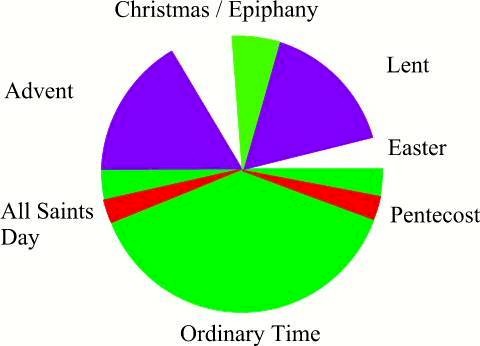Bible | Movies | Books | People | Hot Topics | Holidays | Humor | Gallery | Sanctuary | Sermons | Prayer | Quizzes | Communities | God | FAQ | Links
|
Sponsored Link |
As humans order or arrange the physical space in which they live, for example, their homes, neighborhoods, and cities, they also have a propensity for ordering time. Most Christian denominations utilize a calendar that has evolved over two millennium in which the year is divided into several seasons, beginning with Advent, the period of four weeks leading up to Christmas. Each of the seasons is associated with a specific color, as well as certain Biblical texts or themes that give focus to public worship and private prayer. Like all calendars, the liturgical
calendar is based on recurring seasons in nature: fall, winter, spring, and summer,
marked out by the movement of the sun (solar calendars of 365 days) or the phases
of the moon (lunar calendars, 12 months of 28 days). The calendar of the Christian
church makes use of both kinds and for this reason can be somewhat confusing as
holidays based on the solar calendar like Christmas always occur on the same date
each year whereas holidays based on the lunar calendar like Easter occur on different
dates each year, reflecting the cycles of the moon. (continued below)
( For a collection of sermons and meditations appropriate to these seasons.) (For detailed discussion of each season.) For the specific dates of the major Christian holidays for 2011 - 2013 The liturgical calendar was developed over many centuries, appropriating rituals common to many cultures, to tell the story of Christ�s birth, death, and resurrection as the pattern not only for the life of the Church and its worship, but also the progress of the individual believer toward union with God. At one level, the seasons of the Christian year are ordered around the life and work of Jesus, beginning with Advent and Christmas. The Christmas season is one of twelve days, ending with Epiphany, which marks the coming of the magi to the stable in Bethlehem where Jesus was born. Epiphany extends for a period of 4 to 9 weeks in which the believer follows the major events of Christ's life, from his baptism which marks the start of his public ministry and ending with Ash Wednesday. During Lent, Christians follow Christ toward the culminating days of Holy Week and Easter in which his confrontation with the "powers and principalities" of this world came to a climax in his death, and then, the resurrection. Following Easter, Christians remember the relatively short period during which the risen Christ appeared to the disciples on earth. According to the creeds, he then "ascended" into heaven; the church was not abandoned by God, however, but rather was blessed by the presence of the Holy Spirit. Pentecost Sunday celebrates that presence in the life of the church and is followed by a season of 24 weeks, often referred to as "ordinary time," in which both the church and the individual believer focus on the work they are called to do in the world as the living "body of Christ." For further discussion of these and other seasons of the Christian Year At another level the cycle of the Church year is understood, not just as a rehearsal of events that happened in the distant past, but as a reflection of those universal themes and patterns that are part of the structure of reality itself. As one follows the trajectory of the Christian year, one is also following the trajectory of the cosmos itself, as it moves from the moment of creation to its final consummation. In this we are all on a journey, an often painful one that leads through many joys and sorrows and many seasons of the heart toward that final moment when we return to the Source. For Christians the journey is not without purpose or direction, but rather points toward the time when all things shall be caught up once again in the unity of a just and loving God.
Please take a moment to let us know you
were here!
If you want to talk with someone in person, please feel free to call 917-439-2305
The Rev. Charles P. Henderson is a Presbyterian minister and is the author of God and Science (John Knox Press, 1986). Charles also tracks the boundry between the virtual and the real at his blog: Next World Design, focusing on the mediation of art, science and spirituality in the metaverse. For more information about Charles Henderson. |
Sponsored Link
|
|||||


